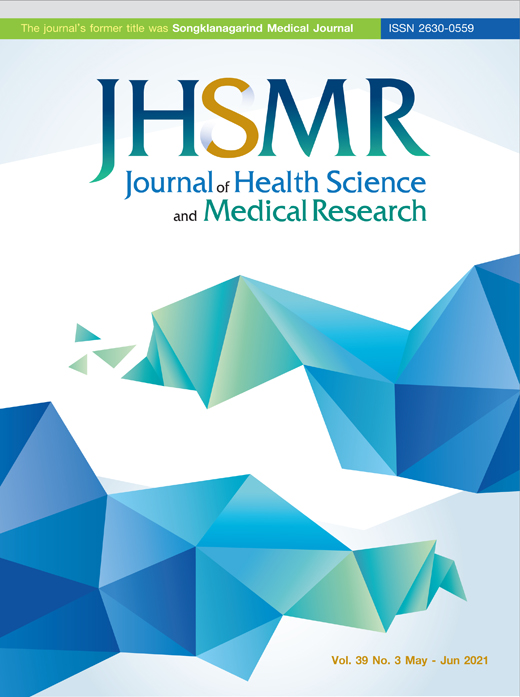Factors Associated with In-hospital Mortality in Severe Burn Patients in Songklanagarind Hospital: A Retrospective Study
DOI:
https://doi.org/10.31584/jhsmr.2020775Keywords:
low-to-middle-income countries, major burn patients, mortality, nomogramAbstract
Objective: This study aimed to analyze the factors associated with mortality in burn patients in order to develop a nomogram for predicting mortality that can be used as a guideline to treat major burn patients.
Material and Methods: This was a retrospective study done in Songhklanagarind Hospital, Hat Yai, Songkhla, Thailand. The study included major burn patients who were admitted to the burn unit or the intensive care unit between the years 2011 and 2018, and analyzed demographic data and significant factors associated with mortality.
Results: A total of 127 major burn patients were treated during the study years, with a mean age of 33 years with an average total burn surface area (TBSA) of 43.5%. The most common cause of the burns was flame injury, and the most significant factors associated with mortality were TBSA >55.0%, blood creatinine >1.2 milligrams per deciliter (mg/dL) and face involvement.
Conclusion: The 3 significant burn-related factors of TBSA >55.0%, blood creatinine >1.2 mg/dL and face involvement can be used to predict mortality using the nomogram created in this study.
References
David N, Rajeev B Ahuja, J F Aili Low, Brett D. Arnoldo, Amina EL Ayadi, et al. Total burn care. 5th ed. New York: Elsevier; 2018.
Fatal Injury Data WISQARS Injury Center CDC [homepage on the Internet]. Atlanta: CDC; 2019 [cited 2019 Sep 17]. Available from: https://www.cdc.gov/injury/wisqars/fatal.html
Siddiqui E, Zia N, Feroze A, Awan S, Ali AL, Razzak JA, et al. Burn injury characteristics: findings from the Pakistan National Emergency Department Surveillance Study. BMC Emerg Med 2015;15:5.
Naghavi M, Abolhassani F, Pourmalek F, Moradi Lakeh M, Jafari N, Vaseghi S, et al. The burden of disease and injury in Iran 2003. Popul Health Metr 2009;7:9.
Zavlin D, Chegireddy V, Boukovalas S, Nia AM, Branski LK, Friedman JD, et al. Multi-institutional analysis of independent predictors for burn mortality in the United States. Burns Trauma 2018;6:24.
Forjuoh SN. Burns in low- and middle-income countries: a review of available literature on descriptive epidemiology, risk factors, treatment, and prevention. Burns J Int Soc Burn Inj 2006;32:529–37.
Fazeli S, Karami-Matin R, Kakaei N, Pourghorban S, Safari- Faramani R, Safari-Faramani B. Predictive factors of mortality in burn patients. Trauma Mon 2014;19. doi: 10.5812 traumamon.14480.
Zhang Z, Kattan MW. Drawing Nomograms with R: applications to categorical outcome and survival data. Ann Transl Med 2017;5:211.
Dokter J, Vloemans AF, Beerthuizen GIJM, van der Vlies CH, Boxma H, Breederveld R, et al. Epidemiology and trends in severe burns in the Netherlands. Burns 2014;40:1406–14.
Gigengack RK, van Baar ME, Cleffken BI, Dokter J, van der Vlies CH. Burn intensive care treatment over the last 30 years: Improved survival and shift in case-mix. Burns 2019; 45:1057–65.
Jeschke MG, Pinto R, Kraft R, Nathens AB, Finnerty CC, Gamelli RL, et al. Morbidity and survival probability in burn patients in modern burn care. Crit Care Med 2015;43:808–15.
Khan N, Malik MAN. Presentation of burn Injuries and their management outcome. J Pak Med Assoc 2006;56:394-7.
Tripathee S, Basnet SJ. Epidemiology of burn injuries in Nepal: a systemic review. Burns Trauma 2017;5:10.
Kobayashi K, Ikeda H, Higuchi R, Nozaki M, Yamamoto Y, Urabe M, et al. Epidemiological and outcome characteristics of major burns in Tokyo. Burns 2005;31:3–11.
Tian H, Wang L, Xie W, Shen C, Guo G, Liu J, et al. Epidemiologic and clinical characteristics of severe burn patients: results of a retrospective multicenter study in China, 2011–2015. Burns Trauma 2018;6:14.
Steinvall I, Elmasry M, Fredrikson M, Sjoberg F. Standardised mortality ratio based on the sum of age and percentage total body surface area burned is an adequate quality indicator in burn care: an exploratory review. Burns 2016;42: 28–40.
Keshavarzi A, Kardeh S, Pourdavood A, Mohamadpour M, Dehghankhalili M. Determinants of the lethal area 50 index (LA50) in burn patients admitted to a tertiary referral burn center in Southern Iran. Bull Emerg Trauma 2018;6:59–63.
Foncerrada G, Culnan DM, Capek KD, Gonz lez-Trejo S, Cambiaso-Daniel J, Woodson LC, et al. Inhalation injury in the burned patient. Ann Plast Surg 2018;80:98-105.
Karki D, Muthukumar V, Jatin B. Concept of lethal triad in critical care of severe burn injury. Indian J Crit Care Med 2019;23:206–9.
Iyun AO, Ademola SA, Olawoye O, Michael AI, Oluwatosin OM. Comparative review of burns with inhalation injury in a tertiary hospital in a developing country wound. Wound 2016;28:1-6.
Dries DJ, Endorf FW. Inhalation injury: epidemiology, pathology, treatment strategies. Scand J Trauma Resusc Emerg Med 2013;21:31.
Berger MM. Nutrition determines outcome after severe burns. Ann Transl Med 2019;7:216. 23. McGill V. Outcome for older burn patients. Arch Surg 2000;135: 320.
Downloads
Published
How to Cite
Issue
Section
License

This work is licensed under a Creative Commons Attribution-NonCommercial-NoDerivatives 4.0 International License.
























